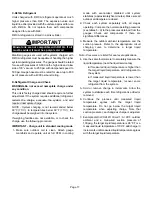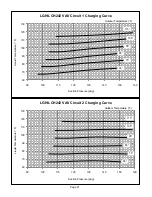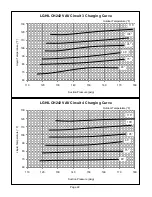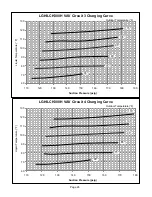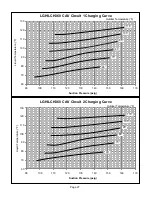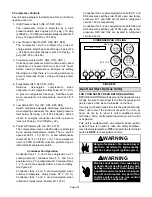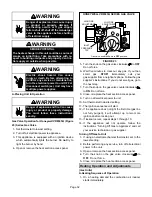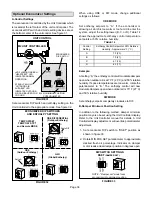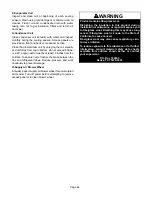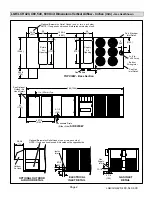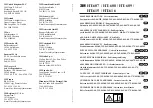
Page 31
F-Compressor Controls
See unit wiring diagram to determine which controls are
used on each unit.
1- High Pressure Switch (S4, S7, S28, S96)
The compressor circuit is protected by a high
pressure switch which opens at 610 psig + 15 psig
(4206 kPa + 103 kPa) and automatically resets at 475
psig + 15 psig (3 103 kPa).
2- Low Pressure Switch (S87, S88, S97, S98)
The compressor circuit is protected by a loss of
charge switch. Switch opens at 40 psig + 5 psig (276
+ 34 kPa) and automatically resets at 90 psig + 5
psig (621 kPa + 34 kPa).
3- Crankcase Heater (HR1, HR2, HR5, HR11)
Units have compressors which contain a belly band
compressor oil heater which must be on 24 hours
before running compressors. Energize by setting
thermostat so that there is no cooling demand, to
prevent compressor from cycling, and apply power
to unit.
4- Freezestats (S49, S50, S53, S95)
Switches de-energize compressors when
evaporator coil temperature falls below 29
F (-2
C)
to prevent evaporator freeze-up. Switches reset
when evaporator coil temperature reaches 58
F
(15
C).
5- Low Ambient Pr. Sw. (S11, S84, S85, S94)
Switch maintains adequate discharge pressure by
de-energizing condenser fan when liquid pressure
falls below 240 psig +10 (1655 kPa+69). Switch
closes to energize condenser fan when pressure
rises to 450 psig +10 (3 69).
6- Thermal Protector (S5, S8, S31, S180)
The compressors used on 242H units are protected
by an external temperature switch. The n.c. switch
opens at 248
F + 9 (120
C + 5) and automatically
resets at 169
F + 18 (76
C + 10). The compressors
used on 300H and 360H units are protected by an
internal thermal protector switch.
Condenser Fan Operation
Condenser fans 1, 2, and 3 are energized on a Y1
cooling demand; condenser fans 4, 5, and 6 are
energized on a Y2 cooling demand. Condenser fans
1, 2, 5, and 6 are energized after a 2 second delay.
See figure 22.
Condenser fans 2 and 5 are de-energized when
outdoor temperature drops below 55
F (13
C).
Condenser fans 1 and 6 are de-energized when
outdoor air temperature is below 40
F (4
C).
Condenser fan 3 is de-energized when both S11 and
S84 pressure switches (via K149) open due to low
pressure. S11 and S84 are located in refrigerant
circuits 1 and 2 respectively.
Condenser fan 4 is de-energized when both S85 and
S94 pressure switches (via K150) open due to low
pressure. S85 and S94 are located in refrigerant
circuits 3 and 4.
4
CONDENSER FAN CYCLING
FIGURE 22
COND.
FAN 4
K150
COND.
FAN 1
K10
COND.
FAN 6
K153
COND.
FAN 3
K149
COND.
FAN 5
K152
COND.
FAN 2
K68
1
2
3
Y1
Y2
S11 & S84
S85 & S94
55
F, 13
C
55
F, 13
C
40
F, 4
C
40
F, 4
C
EVAP COIL
K1
K2
K14
K146
Gas Heat Start-Up (Gas Units)
FOR YOUR SAFETY READ BEFORE LIGHTING
BEFORE LIGHTING smell all around the appliance area
for gas. Be sure to smell next to the floor because some
gas is heavier than air and will settle on the floor.
Use only your hand to push in or turn the gas control knob.
Never use tools. If the knob will not push in or turn by
hand, do not try to repair it, call a qualified service
technician. Force or attempted repair may result in a fire
or explosion.
This unit is equipped with an automatic spark ignition
system. There is no pilot. In case of a safety shutdown,
move thermostat switch to
OFF
and return the thermostat
switch to
HEAT
to reset ignition control.
WARNING
Danger of explosion. Can cause injury or
death. Do not attempt to light manually.
Unit has a direct spark ignition system.
WARNING
Electric shock hazard. Can cause injury
or death. Do not use this unit if any part
has been under water. Immediately call
a qualified service technician to inspect
the unit and to replace any part of the
control system and any gas control
which has been under water.

